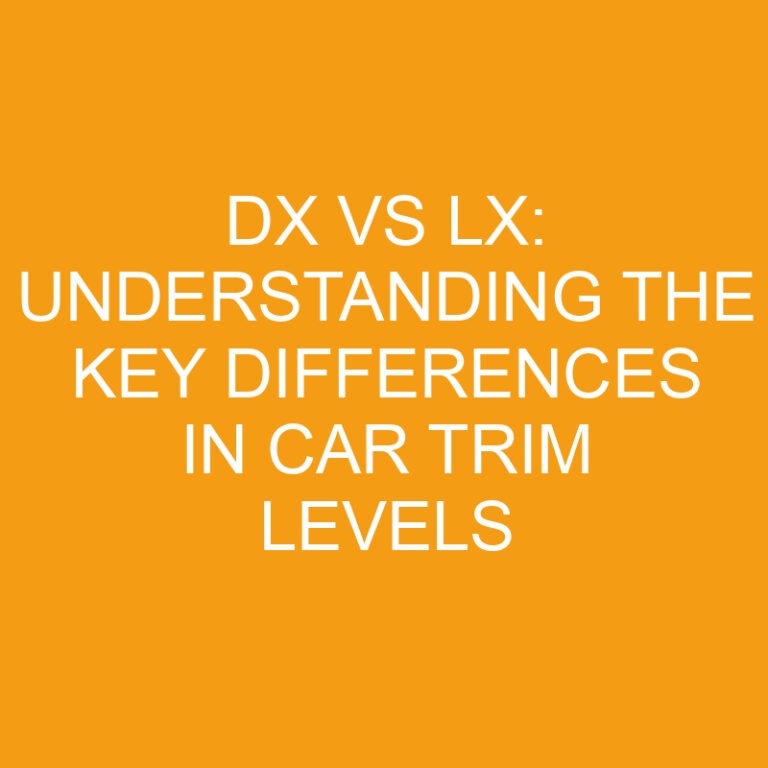
When it comes to diagnosing car issues, having the right tools is essential. That’s where On-Board Diagnostics (OBD) systems come into play. But did you know that there are different generations of OBD systems? In this article, I’ll be diving into the difference between OBD1 and OBD2, so you can better understand which system your car uses and how it affects your ability to troubleshoot problems.
OBD1, or the first generation of On-Board Diagnostics, was introduced in the 1980s and was primarily used by car manufacturers in North America. It was a basic system that provided limited diagnostic capabilities, mainly focusing on emissions-related issues. However, OBD1 systems varied significantly between different car manufacturers, making it challenging to diagnose problems across different brands and models.
Fast forward to the 1990s, and we have the introduction of OBD2, the second generation of On-Board Diagnostics. OBD2 standardized the diagnostic system, making it easier for mechanics and car owners to identify and resolve issues. With OBD2, you have a standardized port under the dashboard, allowing for easy access to diagnostic information. Additionally, OBD2 systems expanded the range of diagnostic capabilities beyond just emissions, providing more comprehensive insights into the car’s overall health.
In this article, I’ll be exploring the key differences between OBD1 and OBD2, including their diagnostic capabilities, compatibility, and the benefits of using OBD2. So, whether you’re a car enthusiast or someone looking to understand their vehicle better, stay tuned to learn more about these two generations of On-Board Diagnostics.
Post Contents
- Key Takeaways
- What is OBD1?
- What is OBD2?
- Diagnostic Capabilities of OBD1
- Diagnostic Capabilities of OBD2
- Compatibility of OBD1 and OBD2
- Benefits of Using OBD2
- Conclusion
- Frequently Asked Questions
- Q: What is OBD2?
- Q: What are the diagnostic capabilities of OBD2?
- Q: Is OBD2 backward compatible with OBD1 vehicles?
- Q: Can OBD2 scan tools be used on OBD1 vehicles?
- Q: What are the benefits of using OBD2?
- Q: How does OBD2 enhance efficiency for mechanics?
- Q: How does OBD2 help diagnose vehicle problems?
- Q: What data retrieval capabilities does OBD2 offer?
- Q: How does OBD2 benefit modern vehicles?
- Q: How does OBD2 contribute to cost savings?
Key Takeaways
- OBD1, the first generation of On-Board Diagnostics, was introduced in the 1980s and had limited diagnostic capabilities and compatibility across different car manufacturers.
- OBD2, the second generation of On-Board Diagnostics, was introduced in the 1990s and standardized the diagnostic system, allowing for easier troubleshooting and comprehensive insights into a car’s overall health.
- OBD1 lacked standardization, had limited diagnostic codes, and offered limited data retrieval capabilities compared to OBD2.
- OBD2 introduced uniform protocols and requirements, increased the number of diagnostic trouble codes (DTCs), and improved data retrieval capabilities.
- OBD2 is backward compatible with OBD1 vehicles, but there are limitations in terms of the level of detail and information provided.
- Benefits of using OBD2 include enhanced standardization, increased DTCs, improved data retrieval capabilities, compatibility with modern vehicles, and long-term cost savings.
What is OBD1?
OBD1, or On-Board Diagnostics 1, is the first generation of diagnostic systems used in automobiles. It was introduced in the 1980s as a way to monitor and identify emission-related issues in vehicles. OBD1 was a significant step forward in automotive technology, as it provided a way to capture and interpret data from various sensors and electronic components in the car.
However, one of the challenges with OBD1 was its lack of standardization across different car manufacturers. Each automaker had its own proprietary diagnostic system, which meant that mechanics needed specific tools and software to diagnose issues. This lack of compatibility made it difficult to perform comprehensive diagnostics on different makes and models of cars.
Despite these limitations, OBD1 laid the groundwork for future advancements in vehicle diagnostics. It introduced the concept of fault codes, which are alphanumeric codes that represent specific problems in the car. Mechanics could use these codes to pinpoint the source of the issue and make necessary repairs.
Overall, OBD1 served as a crucial stepping stone towards a more standardized and comprehensive diagnostic system. It paved the way for the development of OBD2, the second-generation diagnostic system that would revolutionize the automotive industry.
Stay tuned as I delve deeper into OBD2 and explore the key differences between OBD1 and OBD2, including their diagnostic capabilities, compatibility, and the benefits of using OBD2.
What is OBD2?
OBD2, or On-Board Diagnostics 2, is the second generation of the diagnostic system used in automobiles. It was introduced in the mid-1990s and has become the industry standard for vehicle diagnostics. OBD2 builds upon the foundation laid by its predecessor, OBD1, but brings in significant improvements and advancements.
The primary purpose of OBD2 is to monitor and identify issues related to a vehicle’s emissions system, just like OBD1. However, OBD2 goes beyond just emissions monitoring and provides a more comprehensive and standardized approach to vehicle diagnostics. It is designed to track and report various parameters and sensors within the vehicle, allowing for better troubleshooting and maintenance.
One of the key differences between OBD1 and OBD2 is the level of standardization. OBD2 implements a set of uniform protocols and requirements that all vehicles manufactured after 1996 must adhere to. This standardization ensures that mechanics and technicians can use a single diagnostic tool to communicate with and retrieve information from different makes and models of vehicles.
OBD2 also introduces a universal connector, known as the OBD2 port, which is typically located under the dashboard of the vehicle. This standardized interface makes it easier for mechanics to connect diagnostic tools and retrieve valuable data from the vehicle’s onboard computer.
With OBD2, the diagnostics process is more streamlined and efficient. When a fault or issue is detected, the OBD2 system generates diagnostic trouble codes (DTCs) that provide specific information about the problem. These codes can be retrieved using a scan tool and then used to identify and fix the underlying issue.
Overall, OBD2 represents a significant leap forward in vehicle diagnostics, providing improved standardization, compatibility, and diagnostic capabilities. It has not only simplified the troubleshooting process for mechanics but has also made it easier for vehicle owners to understand and address problems with their cars.
Next, let’s explore some of the key differences between OBD1 and OBD2, including their diagnostic capabilities, compatibility, and the benefits of using OBD2.
Diagnostic Capabilities of OBD1
When it comes to the diagnostic capabilities of OBD1, it’s important to understand that this first-generation system laid the foundation for what we now know as OBD2. While OBD1 was certainly a significant development in vehicle diagnostics, it lacked some of the advanced features and standardization that OBD2 introduced.
Here are a few key points about the diagnostic capabilities of OBD1:
- Limited Standardization: Unlike OBD2, which implemented a set of uniform protocols and requirements, OBD1 lacked a standardized approach. Each vehicle manufacturer had its own unique diagnostic procedures and codes, making it challenging for mechanics to communicate with different makes and models effectively.
- Limited Diagnostic Codes: OBD1 systems generated fewer diagnostic trouble codes (DTCs) compared to OBD2. These codes provided general information about the problem, but they were not as specific or detailed as the codes generated by OBD2 systems. This made it more difficult for mechanics to identify the exact issue under OBD1.
- Limited Data Retrieval: OBD1 systems didn’t offer the same level of data retrieval capabilities as OBD2. Mechanics had to rely on proprietary scan tools specific to each vehicle manufacturer, and the data that could be obtained was often limited to basic engine parameters. This lack of comprehensive data made it more challenging to diagnose complex issues accurately.
While OBD1 was certainly a step in the right direction for vehicle diagnostics, its limitations became evident as vehicles became more technically advanced. The need for a more standardized and comprehensive system led to the development of OBD2, which brought significant advancements to the world of vehicle diagnostics.
Diagnostic Capabilities of OBD2
As an expert in the field, I’ve witnessed the significant advancements that OBD2 brought to vehicle diagnostics. With its standardized protocols and advanced features, OBD2 revolutionized the way we identify and troubleshoot issues in automobiles.
One of the major improvements of OBD2 over OBD1 is the enhanced standardization. Unlike OBD1, which had different diagnostic procedures and codes for each vehicle manufacturer, OBD2 introduced a standardized set of protocols and codes. This uniformity allows mechanics to diagnose and repair vehicles more efficiently, saving both time and money.
Another crucial aspect of OBD2 is the increase in the number of diagnostic trouble codes (DTCs) it generates compared to OBD1. While OBD1 generated only a limited number of DTCs, making it challenging to pinpoint specific issues, OBD2 expands the range of codes. This means that mechanics can now identify and address precise problems with greater accuracy.
Furthermore, OBD2 significantly improved the data retrieval capabilities compared to OBD1. It introduced the concept of on-board diagnostics, enabling mechanics to access real-time data from various vehicle systems. With this valuable information at their fingertips, technicians can quickly identify malfunctions, monitor sensor readings, and troubleshoot complex issues.
To leverage the full potential of OBD2, mechanics utilize proprietary scan tools compatible with the standardized protocols. These scan tools allow for comprehensive diagnostic functions, including reading and clearing DTCs, monitoring system parameters, and performing advanced tests.
Overall, OBD2 has empowered mechanics with the tools and information needed to diagnose and repair vehicles more effectively. With its standardized protocols, increased DTCs, and improved data retrieval capabilities, OBD2 has undoubtedly reshaped the landscape of vehicle diagnostics.
Compatibility of OBD1 and OBD2
When it comes to the compatibility between OBD1 and OBD2, there are a few key factors to consider. While OBD2 is backward compatible with OBD1 vehicles, there are some limitations to be aware of.
Firstly, OBD2 scan tools can generally read and retrieve diagnostic trouble codes (DTCs) from OBD1 vehicles. However, the level of detail and information provided may not be as comprehensive as with OBD2 vehicles. This is because OBD1 systems were not standardized and varied across different vehicle manufacturers.
Secondly, while OBD2 scan tools can be used on OBD1 vehicles, the reverse is not true. OBD1 scan tools cannot be used on OBD2 vehicles. This is due to the differences in protocols and codes used by the two systems. OBD2 introduced a standardized set of protocols and codes, allowing for better compatibility and ease of diagnosis across different vehicles.
It’s important to note that while OBD2 scan tools can be used on OBD1 vehicles, they may not be able to access all the features and capabilities that OBD2 vehicles offer. OBD2 vehicles have more advanced systems and sensors, providing additional data and functionality that OBD1 vehicles may not have.
OBD2 is backward compatible with OBD1 vehicles, but there are limitations in terms of the level of detail and information provided. OBD2 scan tools can be used on OBD1 vehicles, but not vice versa. It’s always best to ensure that you have the appropriate scan tool for the specific vehicle you are working on to utilize all the benefits and capabilities of OBD2.
Remember, with OBD2 systems, mechanics are equipped with the power of standardized protocols, increased DTCs, and improved data retrieval capabilities, making vehicle diagnostics and repairs more efficient than ever before.
Benefits of Using OBD2
When it comes to vehicle diagnostics, OBD2 has revolutionized the industry with its numerous benefits. Here are some of the key advantages of using OBD2:
- Enhanced Standardization: OBD2 has introduced a standardized protocol for diagnostic systems across different vehicle manufacturers. This means that mechanics and technicians can use the same scan tools and software to diagnose and troubleshoot issues in vehicles from various brands. This standardization has not only made diagnostics more efficient but has also increased accuracy and reliability.
- Increased Diagnostic Trouble Codes (DTCs): Unlike OBD1, which had limited DTCs, OBD2 provides a much broader range of diagnostic trouble codes. These codes are specific to different components and systems in the vehicle, allowing technicians to pinpoint the exact source of the problem more accurately. With a wider range of DTCs, it is easier to diagnose complex issues and ensure that the correct repairs are carried out.
- Improved Data Retrieval Capabilities: OBD2 offers enhanced data retrieval capabilities compared to OBD1. It allows for real-time monitoring of various parameters, such as engine speed, coolant temperature, fuel consumption, and more. This data can be invaluable in diagnosing and identifying underlying issues, as well as tracking vehicle performance over time.
- Compatibility with Modern Vehicles: OBD2 is designed to work seamlessly with modern vehicles, which are equipped with advanced electronic systems and sensors. It supports communication with a wide range of vehicle modules and can retrieve data from various subsystems. This compatibility ensures that mechanics can access comprehensive diagnostic information for accurate troubleshooting.
- Long-Term Cost Savings: With OBD2, mechanics can quickly identify and resolve issues, reducing the time spent on diagnosis. This not only saves valuable time but also helps prevent further damage to the vehicle. By addressing problems early on, vehicle owners can avoid costly repairs down the line.
OBD2 offers significant benefits over its predecessor, OBD1. Its standardized protocols, increased DTCs, improved data retrieval capabilities, compatibility with modern vehicles, and long-term cost savings make it an essential tool for mechanics and technicians. By utilizing OBD2, professionals can diagnose and fix issues more efficiently, ensuring optimal vehicle performance and customer satisfaction.
Conclusion
OBD2 has revolutionized the automotive industry with its numerous advantages. The enhanced standardization, increased diagnostic trouble codes (DTCs), and improved data retrieval capabilities have reshaped the landscape of vehicle diagnostics. OBD2 is backward compatible with OBD1 vehicles, but it’s important to note that there are limitations in terms of the level of detail and information provided.
By utilizing OBD2 scan tools, mechanics and technicians can benefit from the standardized protocols, increased DTCs, and improved data retrieval capabilities. The standardized protocol introduced by OBD2 allows for efficient and accurate diagnosis across different vehicle manufacturers. The broader range of diagnostic trouble codes makes it easier to pinpoint the exact source of problems and ensure correct repairs. Additionally, the improved data retrieval capabilities enable real-time monitoring of various parameters and comprehensive diagnostic information.
Overall, OBD2 is an essential tool for mechanics and technicians. It not only enables efficient diagnosis and optimal vehicle performance but also helps save time, prevent further damage, and avoid costly repairs. With its compatibility with modern vehicles and long-term cost savings, OBD2 has become an indispensable asset in the automotive industry.
Frequently Asked Questions
Q: What is OBD2?
OBD2 stands for On-Board Diagnostics 2 and is the second generation of the diagnostic system used in automobiles.
Q: What are the diagnostic capabilities of OBD2?
OBD2 brings enhanced standardization, increased diagnostic trouble codes (DTCs), and improved data retrieval capabilities to vehicle diagnostics.
Q: Is OBD2 backward compatible with OBD1 vehicles?
Yes, OBD2 is backward compatible with OBD1 vehicles, but there are limitations in terms of the level of detail and information provided.
Q: Can OBD2 scan tools be used on OBD1 vehicles?
Yes, OBD2 scan tools can be used on OBD1 vehicles, but the reverse is not possible. Ensure you have the appropriate scan tool for the specific vehicle.
Q: What are the benefits of using OBD2?
OBD2 revolutionizes the industry with enhanced standardization, increased DTCs, improved data retrieval capabilities, compatibility with modern vehicles, and long-term cost savings.
Q: How does OBD2 enhance efficiency for mechanics?
OBD2 introduces standardized protocols, allowing mechanics to use the same scan tools and software across different vehicle manufacturers, increasing efficiency, accuracy, and reliability.
Q: How does OBD2 help diagnose vehicle problems?
OBD2 provides a broader range of diagnostic trouble codes, making it easier to pinpoint the exact source of problems and ensure correct repairs.
Q: What data retrieval capabilities does OBD2 offer?
OBD2 offers improved data retrieval capabilities, allowing for real-time monitoring of various parameters and comprehensive diagnostic information.
Q: How does OBD2 benefit modern vehicles?
OBD2 is designed to work seamlessly with modern vehicles, supporting communication with a wide range of vehicle modules and subsystems.
Q: How does OBD2 contribute to cost savings?
By quickly identifying and resolving issues, OBD2 helps save time, prevent further damage, and avoid costly repairs.






